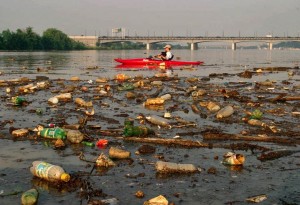Keep America Beautiful was founded in 1953 and its early anti-litter campaigns introduced the word “litterbug.” The New York copywriter who coined the term also wrote the popular TV ad theme in 1963, “Every Litter Bit Hurts.” It was incredibly effective.
Litter has always been a pet peeve of mine. So I was especially interested a decade ago when the EPA decided to use its Clean Water Act power to do something about trash in the rivers in Los Angeles. This is the same power that is so controversial when EPA tries to regulate “total maximum daily loads” (TMDLs) of various minerals and nutrients in major waterways like the Mississippi, the Gulf of Mexico, and the Chesapeake Bay. Those efforts come dangerously close to an EPA takeover of farming and other land uses on which our economy depends.
In Los Angeles, though, EPA took on something far less controversial. Pollution of our waterways by everyday trash is an immense problem, as nearly everyone agrees. So EPA published its TMDL rules for California, establishing an acceptable threshold of zero for trash in the Los Angeles River watershed. Some observers thought the standard too strict and there were lawsuits about it (settled in favor of EPA), but in our hearts most of us know that is exactly the right goal – no trash being thrown into the rivers.
Reasonable people disagree about the regulatory approach to achieving that goal. But this is about the goal itself. It is an issue again today because the EPA has finally decided, after years of wrangling, to publish its plan for cleaning up trash in the Anacostia River. Yet this time the goal is stated in a completely different manner – not based on how much trash gets into the river, but on how much should be cleaned up. That may sound similar, but hang on – there is a world of difference in the resulting regulations.In the Anacostia River, EPA proposes not to stop trash from getting into the water, but relies on a much more convoluted model for establishing a baseline, against which to measure cleanup efforts. The agency estimates that 1.2 million pounds of trash gets into that watershed annually, so it proposes to measure cleanup against that number.
Set aside the shock of over a million pounds of trash per year in a river less than 9 miles long. The question should be, can we stop people, companies, and governments from throwing their trash into it? Instead, EPA is asking whether we can clean it all up. Several environmental organizations have cried foul and are suing, seeking the same standard as applied in California. They are right – not because the California approach is enviable, but because the same standard should apply everywhere. If it is wrong, it should be changed everywhere, but selective enforcement and double standards are the reasons so many Americans find EPA so exasperating.
So why the double standard? There is one, and only one, clear reason for the government’s completely different approach to the Anacostia River: it is in Washington, D.C. For decades the federal government was among the nation’s worst polluters but failed to enforce the law against itself. The power plant that supplies the U.S. Capitol building was among the country’s last to come under jurisdiction of the Clean Air Act, for the same reason Congress used to routinely exempt itself from laws. But most of those antiquated stories of government hypocrisy are in the past, as more recent Congresses have applied most of the laws to themselves, too. They should similarly require EPA to apply the same standards, including trash clean-up plans, in D.C. that apply in the other side of the continent.
In case you wonder why the difference in the Los Angeles and Anacostia TMDLs matters, you have to examine the goals. The L.A. approach is based on changing people’s behavior, so it includes taxes on plastic bags, and other fees designed to change consumer habits. That is less about pollution and more about modifying human behavior. It is social engineering on a grand scale, whereas the Anacostia approach simply says we ought to go clean up the trash.
Cleaning up trash is important, but it would be better to dispose of it properly in the first place. And for that, EPA will find new taxes and regulations far less effective than the old ad campaigns that raised our awareness and made us want to pick up our trash, because every litter bit hurt.
A version of this column originally appeared in the Grand Junction Daily Sentinel September 30, 2016.





Comments on this entry are closed.